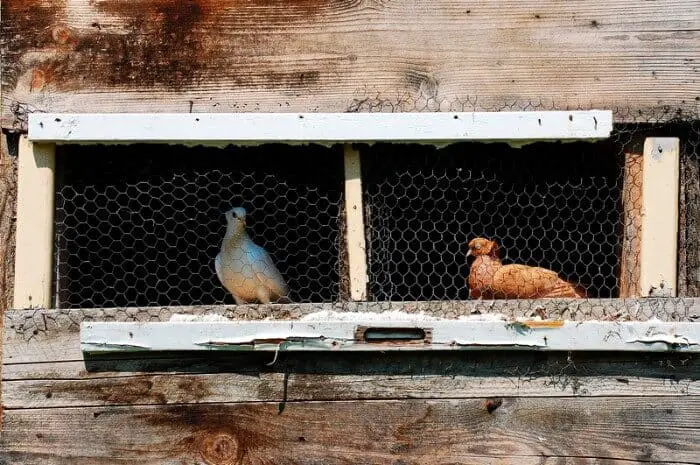Whether you want to keep pigeons as pets or to race, they need a safe home.
With some rudimentary DIY skills you can build a pigeon coop in a suitable place in your garden, backyard, or even on a balcony.
Looking for easy-to-follow detailed step-by-step designs written by expert aviary builders?
The How To Build An Aviary eBook has everything you need and more…
> View Now <

Building your pigeon coop starts by choosing the right place to position your coop. It should be sheltered from rain but exposed to sunlight.
You need to allow enough space for the number of pigeons you have/wish to have. The general rule of thumb is that 7 foot x 6 foot is the right size for 20 pigeons / 10 breeding pairs.
As an Amazon Associate I earn a small fee from qualifying purchases made through Amazon links. This helps us run the site – thanks for your support!
The Equipment you will need is:
- Tape measure
- Graph paper
- Pencil
- 4×4 boards
- 2×4 planks
- Plywood
- Plexiglass
- Wire screen/chicken wire
- Optional – sheet metal
- Saw
- Drill
- Wire cutters
- Hammer
- Nails
- Screws
- Shovel
- Rope
How much you require of the construction materials will depend on how large you want to build the coop.
Step By Step Process of Building a Pigeon Coop

Hint: Keep the design simple. A pigeon coop needs to have four walls, a floor, a roof, roosts, nests, and vent. It is also best elevated from the floor – even short legs are fine. A simplistic design is something that should be able to be built by someone with minimal DIY skills.
1. Measure Up
Measure the area where you’re going to erect the coop. Draw this area to scale on a piece of graph paper.
2. Materials
Work out how much of each material you need.
The biggest pieces will be those needed for the surface area of the roof and floor and back and sides. If the area is suitable, you might not require a rear wall. If you are building the coop outside , you should consider whether you weatherproof the coop with sheet metal or if you’ll just paint it.
Weatherproofing is important because a damp coop can encourage the growth of bacteria and mold which can harm the pigeons.
You will need sufficient plywood to build the surface area of the outer and interior walls and floor and enough sheet metal to cover the roof and outer walls. And you’ll need enough 2x4s to construct the frame. Be sure to stock up on enough screws and nails.
To determine the specific amount:
- Plywood for the floor and roof – multiply the length by the width to get square feet – you will need two of this size
- Plywood for the walls – multiply the length by the width and then multiply by two for the side walls
- Plywood for the back – multiply length by width in square feet
If you are going to build internal nesting boxes (compartments), you also need the plywood for this.
The last thing to work out is the number and lengths of 2x4s and 4x4s you need. You’ll need sufficient for the frames and legs. If the coop is large, you should consider having 2x4s to strengthen the structure at its midway point.
3. Frame & Floor
You can now start to build. First the frame and the floor.
Dig four holes for the corner posts. They should be 1 foot deep. Cut 12 inches from two of your 4x4s. Put the two shortened 4×4 in each of the front holes and fill in, patting in the dirt firmly around the board. Repeat with longer 4×4 for the back two holes.
On each corner 4×4, measure up 12 inches from the ground and make a mark. Now fix a 2×4 to the front of the 4×4 at the mark you made. Repeat for each side.
Now measure 6 feet up from the bottom and nail another 2×4 in place. Cutting 2×4 boards to the correct measurements, nail them in place to make the frame for your floor. Now screw or nail measured and cut plywood sheets to create the floor.
4. Build The Walls
Now the walls.
First the supports. From one of the corner 4x4s, measure 12 inches. Nail/screw a 2×4 to the 2×4 nailed at the top of the corner board and to the floor. Repeat this, every 12 inches around the coop.
To create the walls, fix plywood to the 4×4 corners and 2x4s, making sure the plywood boards are not taller than the shortest 4x4s forming the corners.
Now cut out a door on the front and window measuring a square foot on both sides.
5. Install The Roof
On to the roof. Nail/screw four 2x4s together to create a frame slightly larger than the coop.
Fasten plywood to cover the frame. If you intend to weatherproof your coop with sheet metal, attach it to the roof piece now., then set aside.
6. Attach The Wire Screens
Tackle the window spaces. Attach wire screen to each window – staples are best for this. The wire allows for ventilation.
Cover the rest of the coop with sheet metal making an opening for the window and door.
Cut sheets of Plexiglas slightly larger than the window holes. These are to make the window panes which can be opened and closed as desired.
Drill a hole in each pane in the bottom center and top center. Hammer in a long nail just above the center of the window hole. Place the Plexiglas pane on the nail. Now, measure the distance between the two holes in the Plexiglas pane and measure and mark that distance directly above the first nail. Hammer in a long nail at that point. With both nails in place you should be able to move the pane on its axis to the upper nail to “open” the window. Repeat for the second window.
You can now secure the roof in place. Add wire screen to the triangular gaps that appear on both sides of the coop.
7. Fit Roosting & Nesting Spots
You can now create roosting and nesting spaces. You can create shelves for the birds to roost on by nailing 2x4s in the coop and create nesting spaces with strips of plywood which should be of a depth less than the depth of the coop.
8. The Door
The last item is the door. Mark out places for hinges on both of one edge of the door frame and a piece of plywood cut to the door space size. Make a hole in the door panel before screwing the hinges into place.
Hammer a nail in a suitable place and thread some rope through the hole in the door. This can then be tied to the nail to keep the door open when required.
Also Read:
- Free Dovecote Plans – Build Your Own Dove House
- How to make a nest box for pigeons: simple nest box plans
Maintaining Your Pigeon Coop
The coop should be a nice home for your birds. It should contain water which should be regularly refreshed. Feed them twice a day but do not leave a pile of grains/food for them as they will overeat.
The coop also needs to be a safe place for your birds. This means making sure it is clean and free of hazards.
Regularly clean the floor of feathers, faeces, and other debris as these can cause damage to their feet over time. Also brush the same off the shelves and nesting boards. If you want to put straw on the floor and simply sweep this out and replace regularly, do so.
Make periodical inspections of the coop structure. Check for dislodged nails, splinters, breakages, and anything that could injure a bird.

